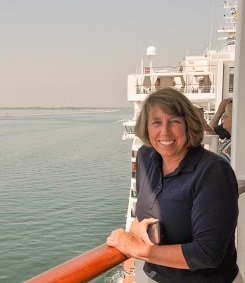
Welcome!
The links on this page connect you to my teaching and research interests.
My research is focused in three general areas:
- the impact of technology in safety-critical systems
- risk analysis and risk mitigation in large-scale systems, and
- the role of human and organizational error in high-consequence settings.
My research utilizes information systems, data science, advanced analytics and visualizations to address changes in large-scale safety-critical systems.
In early work, my research group developed a series of embedded intelligent ship's piloting systems for government, shipping, and piloting organizations. Our research also focuses on evaluating the impact of technology on individuals, groups, and organizations in safety-critical settings We have also conducted several risk assessments in marine transportation and other mission-critical systems.
At present, our research focuses on
- using advanced analytics and visualization techniques such as machine learning, intelligent systems and wearable augmented reality displays to study technology impacts on operator performance, situation awareness, communication and mobility in safety-critical settings,
- exploring resource allocation and critical infrastructure challenges in resource-limited settings such as the Arctic,
- examining the impact of unmanned and autonomous systems in safety-critical settings, and
- discovering and validating predictive safety indicators, in distributed, large-scale systems.
The links on this page should give you an idea of my research and teaching, and provide links for more information.
Current Research
- Advanced Reasoning and Visualization in Safety-Critical Systems
- Moving and Improving in Safety-Critical Systems: Impacts of Head- Mounted Displays on Operator Mobility, Performance and Situation Awareness (International Journal of Human Computer Systems, 2021)
- Through the Looking Glass(es): Impacts of Wearable Augmented Reality Displays on Operators in a Safety-Critical System (IEEE Transactions on Human Machine Systems, 2019)
- Impacts of Wearable Augmented Reality Displays on Operator Performance, Situation Awareness and Communication in Safety-Critical Systems (Applied Ergonomics, 2019)
- Evaluation of WIAR Technology in Safety-Critical Systems -- Research Framework: Design for Staten Island Ferry (Safety Science, 2018)
- Evaluation of Wearable Immersive Augmented Reality (WIAR) Technology for Ship Navigation at MITAGS (Marine Technology, 2016)
- Evaluation of WIAR Technology for Ship Navigation (Journal of Navigation, 2015)
- Unmanned and Autonomous Systems Evaluation and Modeling
- Asset Tracking, Condition Visibility and Sustainability using Unmanned Aerial Systems in Global Logistics (Transportation Research Interdisciplinary Perspectives, 2020)
- Resource Allocation Modeling and Analytics (Arctic Oil Spill Response, Search & Rescue (SAR))
- Optimizing the Response to a Mass Rescue Events (Working paper, 2021)
- Emergency Management, Climate Change and Complex Governance in the Arctic (More than Nature: Research on Infrastructure and Settlements in the North, 2021)
- Breaking the Ice: ISE to Play Key Role in Shaping Arctic’s Future (Institute of Industrial & Systems Engineers, 2019)
- Dynamic Network Modeling for Arctic Supply Chain Logistics (European Journal of Operational Research, 2017)
- National Academies Arctic Oil Spill Response Report 2016 Video
- National Academies Arctic Oil Spill Response Report 2016
- Data Challenges in Dynamic Large-Scale Resource Allocation in Remote Regions (Safety Science, 2016)
- Predictive Analytics, Machine Learning, Leading Indicators, Safety and Security Indicators
- Machine Classification and Sentiment Analysis for Organizational Learning: Accident and Incident Analysis in Safety-Critical Systems (To be submitted to Accident Analysis & Prevention, 2021)
- Predicting Risk in Maritime Transportation: Preventing Disruption in Global Logistics and Supply Chains (Under revision for Production & Operations Management, 2021)
- Self Healing Databases for Predictive Risk Analytics in Safety-Critical Systems (Journal of Loss Prevention in the Process Industries, 2020)
- U.S. Coast Guard/ Department of Homeland Security (DHS)/US Coast Guard Data Risk Analytics Final Report: Literature Review, Requirements, Analysis & Recommendations for Data Sources and Analytical Methodologies. (U.S. Department of Homeland Security, Command, Control & Interoperability Center for Advanced Data Analysis (CCICADA) Report, Task Order Task Order HSCG23-17-J-MSR065, August 2018)
- Leading Indicators of Safety in Virtual Organizations (Safety Science, 2007)
- Accident Precursors and Safety Nets: Leading Indicators of Tanker Operations Safety (Maritime Policy & Management, 2007)
- Virtual Organizations, High Reliability Organizations, Organizational Resilience
- Reliability Seeking Virtual Organizations: Challenges for High Reliability Organizations and Resilience Engineering (Safety Science, August 2019 )
- Terrorist Critical Infrastructures, Organizational Capacity & Security Risk (Safety SCience, December 2018)
- Team Composition, Team Performance
- Linking Team Composition and Team Performance: An Application to Post Disaster Debris Removal Operations (IEEE Transactions on Human-Machine Systems, 2014)
- Safety Culture and Safety Performance
- Linking Workplace Safety to Operational Disruptions (Journal of Business Logistics, December 2018)
- Decision Performance and Safety Performance: A Value Focused Thinking Study in the Oil Industry (Decision Analysis, 2014)
- Sailing on Friday: Linking Safety Culture and Safety Performance (IEEE SMC Part A: Systems and Humans, March 2010)
Contact & More Information
Email: grabowsk@lemoyne.edu
Follow me on Twitter:
- @GrabowskiMIS201: for research links, and information on jobs, internships, scholarships and graduate school opportunities
You can also access my resume/c.v.